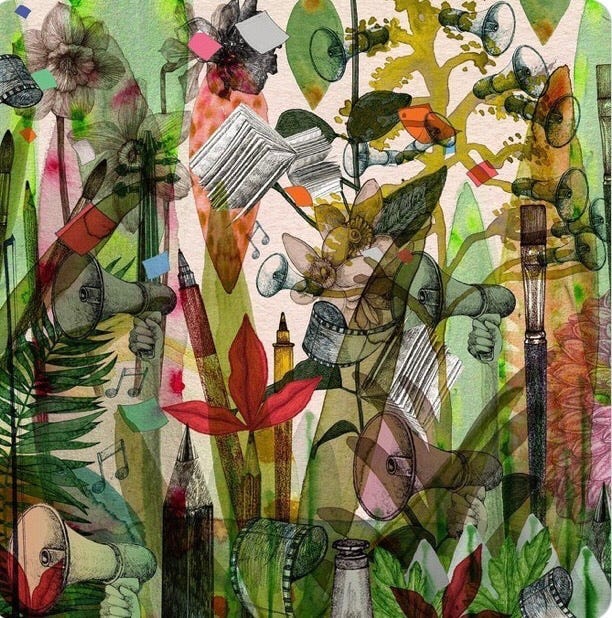A little creek runs behind our house where leftover rain slips quietly through the oak and sweetgum leaf mold. The space between the creek and lawn is a matted and dense tangle of ivy that chokes out native forest plants, creeping up trees, blurring and erasing the bark and shape of limbs, turning them into misshapen lumps of green ivy. It advances up and penetrates the lawn, wiping out the grass.
Every few years I would trim around the tree trunks and pull up a few grasping runners. I would hackthe the hardened bristling woody vines only once in a while did little for the ivy grew back shockingly fast. There was no uprooting the stuff unless I was willing to kill it completely. Pull up the entire root system or those green chains would eventually take down the entire ecosystem.
The whole thing was my responsibility anyway. The jungle of ivy wasn’t there when we moved into our new house. You see, I planted and propagated sprigs to provide a bit of ground cover. I really loved ivy then, but until then had only enjoyed it in containers, flower pots and in photos of it covering English cottages and university buildings.
Fast forward 30 years — here I was, finally determined to do the work: I knew I had to be patient that it would take the whole summer to uproot it all. So I started raking, raking, and raking. Pulling up runners and denying the vines its cover. Surprisingly the plants are not very strong, but there was just so much of it-years of growth on top of untended growth.
I sawed into the thick old hairy vines at the base of all the trees. I pulled out mats of vines that covered the bark and saplings of dogwood and redbud. Within days mayapples and delicate spirals of baby ferns emerged from the forest soil. The saplings, now freed of their restraints, began to grow, taking their natural shape.
My hope that the soil will be healthier and better able to filter the chemical-laden runoff that feeds the creek; health begetting health.
In obedience to God, the Genesis narratives teach us how our first parents stewarded the earth to sustain its growth and health. We follow this calling to cultivate and nurture well-being for all creation. This includes not only the land, but economies and markets, laws and resources for the flourishing of all.
With this in mind, let’s think together:
What else needs uprooting?
How can we use our time, attention, energy, and resources to create beauty and for the thriving of others in this world?
To what, and to whom are we accountable to uproot that which has been untended and continues to crush out life?
At the recent 2022 Hopewords Writers Conference, Dr. Lewis Brogdon, Director of Black Church Studies at Baptist Seminary of Kentucky, who challenged us to exercise our “moral imagination” by:
“Seeing beyond the crisis of present, giving language and imagery for a better tomorrow; “God’s future” and inspiring others to see and desire to live into God’s future in the now.”
The gospel is the message of the miracle of God creating life from death, and sustaining those who put their truth in Christ until the final day when death dies. Yes, reversing the curse is his business and part of that glorious meta-narrative, but as Jesus welcomed the little children to come near, he explained to the offended disciples that they reflected something of the nature of the Kingdom of God. Their reflection of something so good called out Christ’s praise and commendation.
Likewise, when we, by faith, exercise moral imagination to bring healing and joy to others, we are back in the garden, working the works of God. Sometimes cultivating God’s earth requires radical measures in pursuing goodness and human flourishing.
Sometimes it requires pulling up vines,uprooting what has become, over time, an acceptable part of the landscape.
Ripping up to make (the land) whole again. Suffering before rest. Death before life. So goes the Kingdom of God. And this story always ends well.







